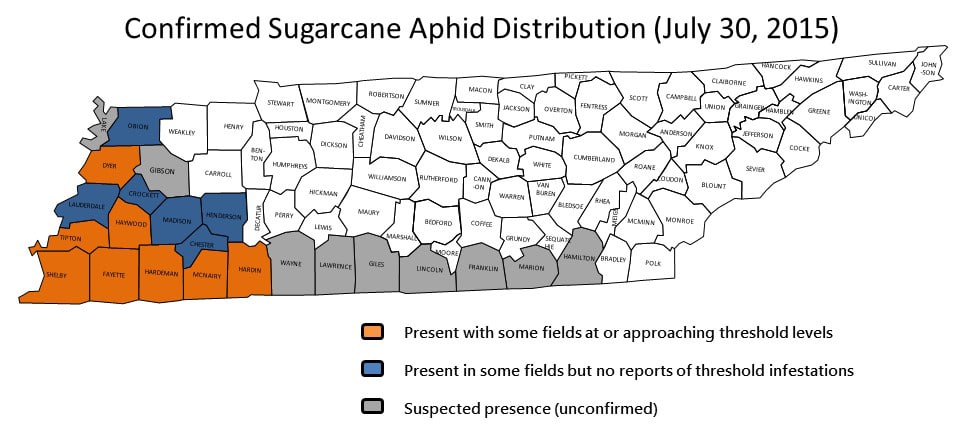The phone has been ringing off the hook about sorghum insect control. Sugarcane aphids are being reported in more fields across a wider area. The map below provides a general status on known infestations at this time. There are also plenty of questions about controlling headworms. Let me provide some information and management suggestions.
In regards to sugarcane aphids, chill out! Finding sugarcane aphids in an area does not mean every field in the county needs an insecticide application. There can be huge differences in aphid populations based on crop maturity, hybrid susceptibility, planting date, and other management factors. The recommended treatment threshold is when 30% or more of plants have aphids present and there are multiple hot spots in the field with 100 or more aphids on a leaf (often found by the accumulation of honeydew). There are only a few fields at this time that have exceeded this recommended treatment threshold, although this is changing pretty quickly. Scouting is needed to time applications!
Not every field will need sprayed for corn earworm, fall armyworm, and/or sorghum headworms! It seems like everyone is wanting to make an application of Prevathon or Besiege, often with a fungicide. These are good insecticides but pricey and should not bee applied without regard to pest pressure. I suggest using a threshold of 1 fall armyworm or corn earworm per head (or 3-4 sorghum webworms). Most of the early sorghum will not break this threshold. Late planted milo is much more likely to cross swords with corn earworms or fall armyworms, but even then, the best approach is to hold off application until infestations are near or exceeding threshold levels. Again, this requires scouting!
Where sugarcane aphids are looming, I suggest avoiding the use of Besiege for headworm control. It is a premix containing a pyrethroid insecticide, and pyrethroid insecticides can greatly aggravate aphid infestations because they negatively impact beneficial insects. Better options include Prevathon or Blackhawk. Heligen is also an option where corn earworm is the primary species present.
Not all fields need a fungicide application! There are more opinions than data about the value of foliar fungicide applications in sorghum. Dr. Heather Kelly and I have done limited testing of foliar-applied fungicides in grain sorghum. These tests show that some fungicides perform well in reducing the severity of at least some diseases found in sorghum. There is some indication of a modest yield increase in our tests, but this will almost certainly vary depending upon weather conditions, crop rotation, etc. Our recent tests have been in milo planted behind milo. It’s a good bet that sorghum after a previous year’s sorghum or corn crop is at a higher risk to diseases. Ample rainfall or irrigation, reduced tillage, and late planting probably also increase the risk. I encourage on-farm evaluations, but not whole-hog fungicide applications across every field based on limited data.
A supposedly ‘cheap to grow’ sorghum crop can become pretty expensive if we blindly apply $40-$50 of insecticide and fungicide on every acre. Common sense and some ground truthing can improve your return on investment. Please refer to previous articles related to the above subjects (linked below).
https://news.utcrops.com/2015/07/sugarcane-aphids-spreading-quickly-in-sorghum/
https://news.utcrops.com/2015/05/steps-for-managing-insects-in-grain-sorghum/
https://news.utcrops.com/2015/07/grain-sorghum-disease-management-2/


